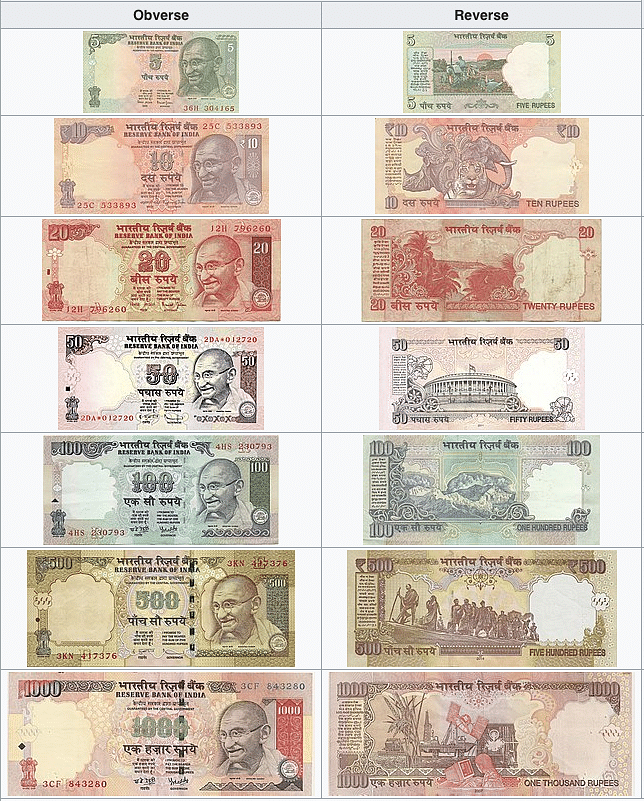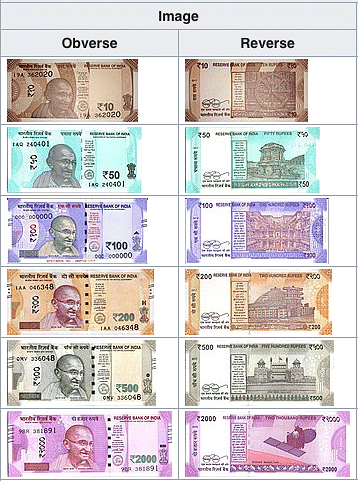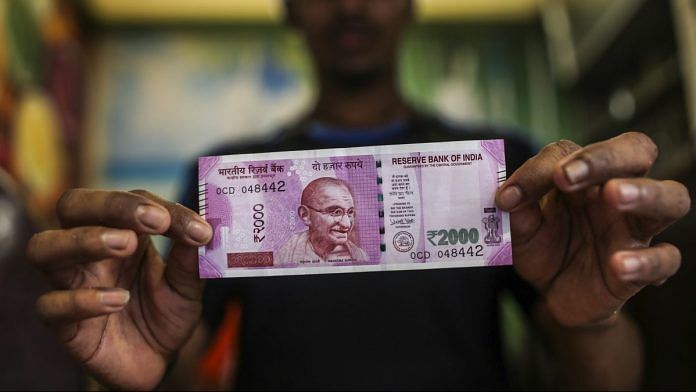The currency note was a prop, the ATM queues an exercise in behavioural psychology.
Soon after Narendra Modi announced demonetisation and we saw images of the new currency notes of Rs 2,000 and Rs 500, liberal commentators started criticising them for their design and aesthetics. On 9 November 2016, liberal timelines on social media were full of aesthetic disgust than the anxiety over standing in ATM queues.
Designer Abhishek Sarda wrote of the new Rs 2,000 note in a post that went viral, “It combines 500-year-old patterns with attempts at a post-modern aesthetic”.
Liberal wrath was particularly directed at the colour pink. “I hate it,” Sarda wrote, “The colour choice could have been much better. Among the reactions I’ve heard so far – “it looks like a bus ticket”, “it looks like a fun-fair coupon”… However, objectively – the highest denomination bank note of our country deserved to look more sophisticated and subtle – stately perhaps – not a in-your-face pink extravaganza.”

In his objection lies the answer. Bus tickets and fun-fair coupons may be missing from the lives of today’s urban elites, who are surrounded by subtle pastel shades. But if you go to the houses of the poor, you’ll find a lot of bright colours. It has since then become clear that the use of shiny bright colours wasn’t limited to the Rs 2,000 note. The new Rs 100 note is lavender, the new Rs 10 note is not the boring old brown but a strong chocolate brown. The Rs 200 note is bright yellow and the Rs 50 note is fluorescent blue.
Also read: Havoc unleashed by demonetisation evident to everyone now, says former PM Manmohan Singh
Only the Rs 500 note is stone grey, but again stronger in colour than the old Rs 500 note. The old Rs 500 note was subtle shades of yellow and green.
On 8 November 2016, Narendra Modi did not just demonetise Rs 500 and Rs 1,000 notes of the “Mahatma Gandhi Series”, but also launched a “Mahatma Gandhi New Series”. Okay, the Reserve Bank launched it, but you know how Modi made himself look like the de facto RBI governor that day. New size, new design, new colours.
It wouldn’t be surprising if Prime Minister Narendra Modi personally asked for the new notes to be colourful. He has a keen sense of the use of colour in his political communication. The clothes he wears, the events his government organises, the images the Modi photo factory produces – they are all colourful.
The bright colours were likely a deliberate choice to appeal to the target audience – India’s poor. They weren’t intended to impress the arbiters of high taste. The bright, basic, more saturated colours were perhaps intended to evoke positive emotions of celebration, joy and festivity, not something that subtle colours would do.
Cynics will discuss this as mumbo-jumbo, but colours matter in all communication. A lot of money is spent by companies all over the world figuring out the right colours for their products and campaigns. Many books have been written on the subject. Different kinds of colours are used to target men and women, children and adults, luxury and economy. Different colours evoke different emotions. There’s a reason why Coca-Cola is red and Apple is white, why luxury hotels use subtle colours and children’s schools are all bright with primary colours.
Also read: Make no mistake- Demonetisation has been as much a political failure as an economic one
Modi’s new notes were an attempt to make people forget a time when Modi wasn’t their leader. It was part of the effort to cast Modi’s prime ministership as a defining moment, a second coming. Nothing happened before 2014, and currency notes became bright and shiny in 2016. Every time you look at the new notes, you might be reminded of Narendra Modi, and in case you’d not, he’s helpfully inserted the Swachh Bharat logo.
Props on the stage
More than the use of colour, demonetisation was brilliant political communication because it used the currency note as a prop. The use of props helps make abstract ideas tangible. In film and theatre, props help with the mise-en-scène, enhancing the performance of actors, making scenes feel more authentic, identifying characters and establishing circumstances.

Nobody used props in politics better than Mahatma Gandhi, who asked people to burn their foreign clothes, then get a charkha, sit down and weave khadi. Similarly, picking up salt to defy the salt tax was another use of a prop to make an abstract idea (civil disobedience) tangible.
We also saw this in the Ram Mandir agitation, wherein bricks were used to mobilise people for the movement. People were made to inscribe ‘Shri Ram’ on bricks, worship them and take them to Ayodhya. This inspired the Loha campaign for the ‘Statue of Unity’ to make Narendra Modi a household name for his 2014 campaign. The prop here was not a brick but a piece of scrap iron, some soil and a photo of the sarpanch. In ‘Chai Pe Charcha’, tea became a prop to instil in people’s minds the idea that Modi came from a humble background, a tea seller, just like the aam aadmi.
There’s no prop like the currency note – everybody has it and wants some more of it.
‘Modi-ji kaam bohot dete hain’
Politicians in power face the challenge of making people see how hard they are working, how much effort they are putting in to improve the lives of their voters. It is not an easy task. Voters don’t have the time or patience to follow the boring news about government policies that don’t make it to the top headlines, which are full of scandal and controversy.
Demonetisation was like a government scheme that literally everybody was forced to participate in. Even if you were a hermit living a reclusive life in a forest, you’d need some currency notes. Sooner or later, you’ll know the notes are worthless, and you’ll ask why. You’ll be told Modi is trying to destroy black money. Mission accomplished.
The act of changing currency notes and standing in queues for a good cause was the best way to force people to learn about Modi, his policies, his intentions. People bought Modi’s ‘anti-rich Kool-Aid’ and patiently stood in queues, thereby putting their faith behind the idea. Once they did so, they found it difficult to be angry about its failure since that would mean admitting they were wrong in buying the Kool-Aid. This is the same marketing idea of ‘pre-commitment’, which was used in the Loha campaign and is now behind the NaMo app’s micro-donation drive.
Also read: Have you ever wondered why Narendra Modi never says ‘I did it’?
Demonetisation failed and boomeranged because it was bad economics: it didn’t destroy black money as promised. Yet, it made people say ‘at least he’s trying’. Even in its failure, it communicated intent.
Modi’s Swachh Bharat is a similar example where he asks people to contribute to cleaning up cities. India’s streets are no cleaner but as a political campaign, it is successful. It makes people see Modi’s good intentions through participative marketing. Modi’s branding is in the homework he gives you. As one comedian joked, Modi ji kaam bohot dete hain (Modi gives us a lot of work).
Contrary to popular myth, demonetisation did not help the BJP win the Uttar Pradesh assembly election in 2017. DeMon was not only an economic failure but also a political one. Modi is no longer able to tell the poor that he’s taking on the rich. He gave up on that narrative and switched over to the ‘New India 2022’ in 2017 itself. Yet, if people are not angry with Modi over the failure of demonetisation, it’s because it was cleverly designed as a branding and marketing exercise in itself.




What is in a note?It is simply a medium of exchange.The colour of the note does’nt matter much it is a childish idea.Modi has a habit of poking his nose even where it is not required.
By the garbage near my house before and after the campaign. Nothing made the difference.
>> “People bought Modi’s ‘anti-rich Kool-Aid’ and patiently stood in queues, thereby putting their faith behind the idea. Once they did so, they found it difficult to be angry about its failure since that would mean admitting they were wrong in buying the Kool-Aid.”
The same could be said about the communists, isn’t it? In their case, its worse as they not only brainwash the revolutionaries, but also ask them to pick guns and fight against the state. But I’m sure you won’t say a word against the communists or the #UrbanNaxals. This article is just out of desperation of not being able to find anything tangible against Modi ji!
>> Modi’s Swachh Bharat is a similar example where he asks people to contribute to cleaning up cities. India’s streets are no cleaner but as a political campaign, it is successful.
On what basis can someone claim “India’s streets are no cleaner” ???
Read the very last sentence of this article:
“Yet, if people are not angry with Modi over the failure of demonetisation, it’s because it was cleverly designed as a branding and marketing exercise in itself.”
The entire article is full of such puzzling statements.
If you don’t understand why I’m saying this, read the very opening lines of the article:
“The currency note was a prop, the ATM queues an exercise in behavioural psychology.” (????)
I guess it’s all meant for intelligent people.
My sense – it could be off by a few months – is that till about demonetisation, the world had a favourable opinion about the Indian economy. Its growth momentum was picking up, India stood out against an anemic background. After that, other economies have been doing well, India is seen as averse to reform, not achieving its potential. The flight of capital this year has been painful. Management of such a large, complex economy, which feeds over a billion people, cannot be an instinctive, gut feel, seat of the pants exercise. A pot of gold containing four trillion at the end of the demonetisation exercise proved to be illusory. There is apparently a pot of equal size hidden in the RBI’s reserves. One can only hope history will not be repeated. It would wreck global confidence in the management of the Indian economy.
SPOT ON!
The conclusions drawn in the article are at best the personal opinion of the author..they are not supported by data.. another example of broad brushing own opinions as public views/sentiments..the ground realities are different though..